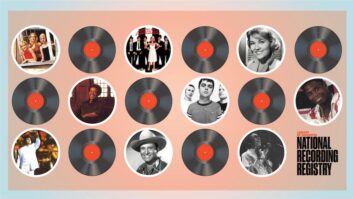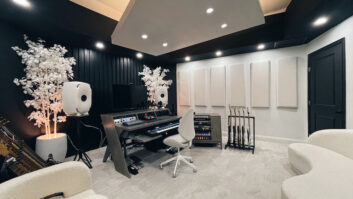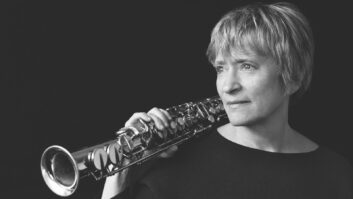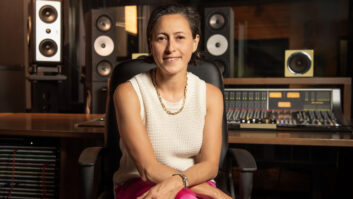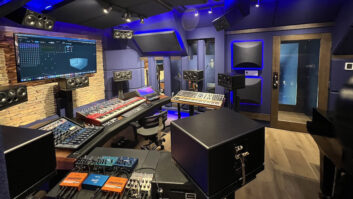ANTIOCH, CA—After several years of separately developing their own mobile workstations for use on the road, veteran touring FOH engineers Brad Madix and Greg Price partnered up to create Diablo Digital, Inc. in 2013. The rigs, ranging from very compact rack-mounting solutions to standalone road case racks, are custom-configured to meet the needs of Diablo Digital’s clients, but are essentially standardized on components from Apple, Avid and Sonnet Technologies.
The incorporation of multitrack recording and playback into the live performance workflow is nothing new, of course. But now, it seems, whether for multitrack recording for archiving, release or virtual soundcheck, playback of tracks to reinforce the performance, or for on-the-road editing, artists and their touring engineers are embracing mobile workstations.
Brad Madix of Diablo Digital with one of the company’s live multitracking solutions, featuring Avid Pro Tools|HD software running on a Mac Mini in a Sonnet housing that also provides storage and console interface. “You are seeing people multitracking shows way more often than you did a few years ago,” says Madix, currently on tour with Rush. Madix’s resume also includes Beck, Van Halen, Shakira, Alanis Morissette, Jane’s Addiction and many others. “Dierks Bentley has used our systems for a long time, Soundgarden had a system for a while, and Ozzy Osbourne and Black Sabbath both use them,” he says.

“I tried to do this with Shania Twain back in 2004; we were lucky to get through a show,” he continues, adding, “I didn’t get into this to start a company; I got into it because I was frustrated with the gear I was getting.” Happily, technology has advanced and now compact yet very powerful systems may be easily packaged to withstand the rigors of touring.
Having individually assembled systems based on bulkier Mac Pro computers, Madix and his San Francisco Bay Area neighbor Greg Price—whose own touring credits include the likes of Van Halen, Rage Against the Machine, KISS, Aerosmith and others—first put their heads together a couple of years ago to develop a more roadworthy rig. Sonnet’s xMac Mini Server, a Thunderbolt-to-PCIe 2.0 expansion system and 1U rackmount enclosure, offered a suitably compact solution.
“We tend to pop an Avid Native card in there, but we have done them with HDX cards as well,” Madix elaborates. “We’re not looking for plug-in power capacity as much as just getting onto the hard drive and back out again.”
Diablo Digital’s compact system includes Avid Pro Tools|HD software running on the Mac Mini, with the Pro Tools|HD Native PCIe card providing an interface to the Avid Venue console. Typically, a Sonnet Tempo SSD PCIe storage card in the second slot acts as the record drive. The system has a 64-track I/O capacity.
“We get a lot of work for those things,” says Madix. “They’re relatively inexpensive, which is really what drove us in the beginning. We’re trying to get to the point where essentially you can throw this in with the system.” But, he notes, connecting to a DiGiCo or Midas desk is slightly more complex and therefore more expensive, involving a DigiLink-to-HDX card or AES50 interface respectively.
A physically larger Diablo Digital system—still only 3RU—comprises a Sonnet Echo Express III-R rackmount Thunderbolt 2-to-PCIe card expansion chassis together with Sonnet’s RackMac, a mini rackmount enclosure for the Mac Mini, which includes a CD-R drive. The Echo Express III-R, which is Avid-qualified, supports 20 Gbps Thunderbolt 2 technology.
Madix has this particular system out with Rush, configured with a SATA controller card and two Avid HDX cards, and Fleetwood Mac is using a similar system, he says. “The SATA controller card is basically for media; the basic version has three 3.5-inch hard drives, although there are various ways to configure it. That gives us 128 in and out. If we take the two systems—the xMac Mini and the Echo Express III—we can configure a system that is 196 I/O,” he says.
Diablo’s earlier system is a three-foot-tall rack with a built-in screen. “They were all based on Pro Tools|HD, so they tend to be 96 in and out. It’s a good form factor; sometimes it’s nice to have a separate piece instead of something you have to put in a rack.” The Rolling Stones just wrapped up a tour with two systems, he says, while the current U2 tour is out with multiples of both the xMac and Echo Express III systems.
“Aside from really great support, the form factor is what originally drew us to Sonnet,” says Madix. “They were the first with a rack-mountable, all-inclusive server built around the Mac platform, which we also chose for its reliability.”
The systems have been performing well, he continues. “These things take a beating, as you can imagine. But we feel very confident that they can take the punishment.”
Happily, the market for mobile workstations seems to be growing, as evidenced by the fact that Diablo Digital now has more than 30 systems available. “I’d love to see it become ubiquitous, and to see our machine in everybody’s hands. And I’d love to see more engineers wake up to the possibilities. I think they’re now starting to see how helpful it can be.”
Diablo Digital
diablodigital.com


